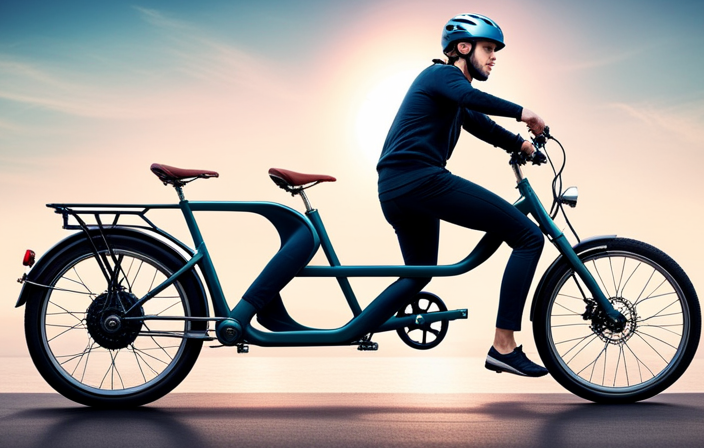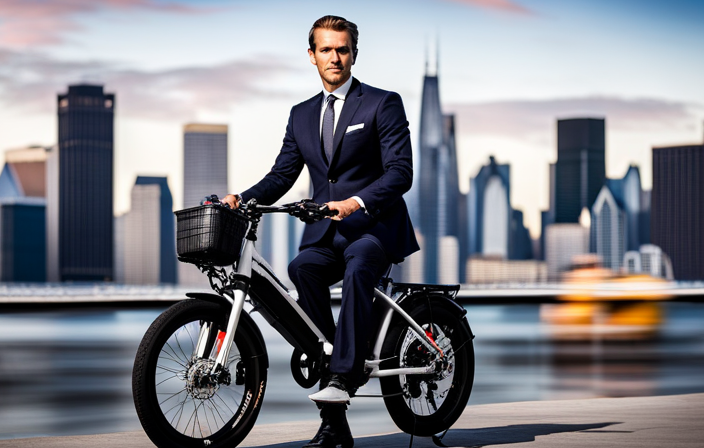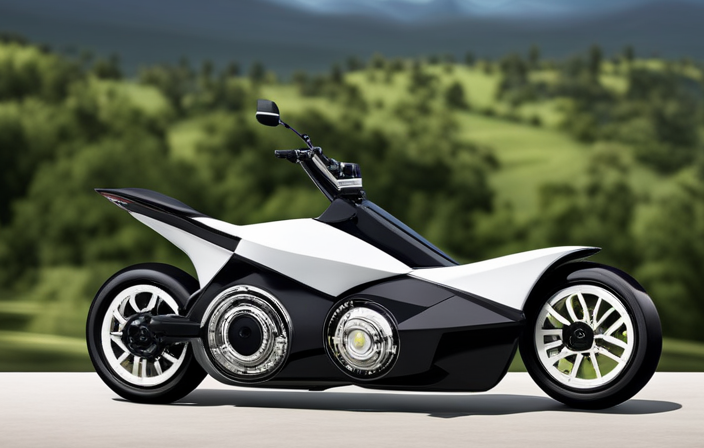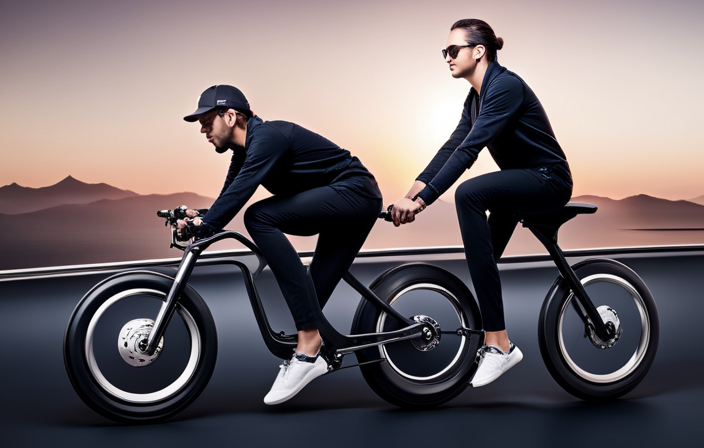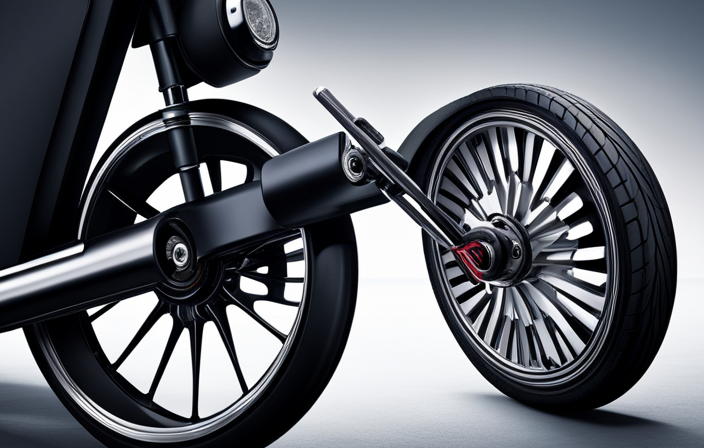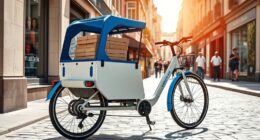I’ve always loved the feeling of riding a bike, but lately, I’ve been yearning for a little more speed and power.
That’s when I stumbled upon a solution that has completely transformed my biking experience: putting an electric scooter motor on my bike.
In this article, I’m going to show you step-by-step how to do it yourself. Get ready to take your bike to a whole new level of exhilaration and convenience.
Let’s dive in!
Key Takeaways
- Connecting and adjusting the motor is essential for optimizing motor performance and identifying potential issues.
- Regularly checking and adjusting voltage output ensures efficient motor performance and compliance with manufacturer’s specifications.
- Adjusting controller settings allows for customization of throttle response, acceleration, and maximum speed for desired performance.
- Optimizing battery usage, including monitoring voltage levels and charging regularly, enhances motor efficiency and extends battery life.
Assess Your Bike and Motor Compatibility
You’ll need to check if your bike and the electric scooter motor are compatible. Bike motor compatibility is crucial to ensure a successful installation.
To find the right motor for your bike, start by examining the frame and fork. Look for enough clearance and mounting points to attach the motor securely. Consider the weight and size of the motor, ensuring it won’t affect the bike’s balance or maneuverability.
Additionally, assess the bike’s drivetrain, as the motor may require modifications or an upgrade. It’s essential to select a motor that matches your bike’s voltage and power requirements.
Once you’ve determined the compatibility, you can move on to gathering the necessary tools and materials for the installation process.
Gather the Necessary Tools and Materials
To get started, first make sure you have all the tools and materials you’ll need for this project. Here are the essential items you should have on hand:
-
Electric scooter motor: Choosing the right motor size is crucial for a successful installation. Research various options and select a motor that aligns with your desired power and speed requirements.
-
Wrench set: You’ll need a set of wrenches to remove and attach various components during the motor installation process.
-
Allen wrenches: These are necessary for loosening and tightening bolts, especially when dealing with the motor bracket.
-
Screwdriver set: A set of screwdrivers will come in handy for removing and installing screws in different parts of the bike.
-
Motor installation guide: It is vital to thoroughly research motor installation guides specific to your bike model. These guides provide step-by-step instructions and safety precautions to ensure a proper installation.
Now that you have all the necessary tools and materials, you can move on to the next section: removing the rear wheel of your bike.
Remove the Rear Wheel of Your Bike
Start by loosening the bolts on the rear wheel using the appropriate wrenches. When installing an electric scooter motor on a bike, removing the rear wheel is a crucial step. There are alternative methods to consider, such as removing the chain or detaching the motor from the frame. However, removing the rear wheel offers several advantages.
Firstly, it allows for easier access to the bike’s frame, making it simpler to attach the motor mount securely. Secondly, it provides a clear view of the wheel hub, enabling proper alignment of the motor.
On the other hand, removing the rear wheel can be time-consuming and require additional tools. Additionally, it may require readjustment of the brakes and derailleur upon reinstallation.
With the rear wheel removed, we can now move on to the next step: installing the electric scooter motor mount.
Install the Electric Scooter Motor Mount
Once the rear wheel is removed, it’s time to attach the motor mount for the electric scooter. This is a crucial step in converting your bike into an electric scooter. Here are three important things to consider during this process:
-
Motor Types: There are various electric scooter motor types available, including hub motors and mid-drive motors. Each type has its own advantages and considerations, such as power output, efficiency, and installation complexity.
-
Benefits of Installing an Electric Scooter Motor: Adding an electric scooter motor to your bike can provide numerous benefits. It allows for effortless commuting, reduces physical effort, and extends the range of your bike. Additionally, it promotes eco-friendly transportation by reducing carbon emissions.
-
Proper Mounting: When installing the motor mount, ensure it is securely attached to the frame of your bike. Use appropriate tools and follow the manufacturer’s instructions to ensure a safe and stable installation.
Attach the Electric Motor to the Mount
Next, you’ll need to securely fasten the motor to the mount, ensuring a stable connection. This step is crucial in the electric motor installation process as it ensures the motor stays in place while in operation.
To attach the motor to the mount, locate the mounting holes on both the motor and the mount. Align these holes and insert the appropriate screws or bolts through them. Make sure to tighten them securely without over-tightening, as this may damage the motor or the mount.
It’s important to double-check the alignment and connection to ensure everything is properly attached. Once the motor is securely fastened to the mount, you can proceed to the next step of connecting the motor to the battery, which will provide the necessary power for the motor to function.
Connect the Motor to the Battery
Now that the electric motor is securely mounted on the bike, it’s time to connect it to the battery. This step is crucial as it ensures the motor receives the necessary power to propel the bike forward.
To begin, locate the connecting wires that came with the motor kit. These wires will have specific connectors for both the motor and the battery. Match the connectors accordingly, making sure they fit snugly and securely.
It is important to double-check the connections to ensure there are no loose or exposed wires that could lead to potential issues or accidents. If any troubleshooting issues arise, consult the motor kit’s instructions or seek professional assistance.
Once the motor is successfully connected to the battery, we can move on to securing the battery to your bike.
Secure the Battery to Your Bike
To ensure the battery stays in place during rides, it’s important to securely fasten it to your bicycle. Here are some alternative methods for securing the battery to your bike:
-
Use a battery mounting bracket: This is a popular option as it provides a secure and stable platform for the battery.
-
Utilize Velcro straps: These can be wrapped around the battery and attached to the frame or bike rack for a firm hold.
-
Consider using zip ties: They are inexpensive and can be tightly fastened around the battery and attached to the bike frame.
-
Use a battery bag or pouch: These specially designed bags provide a safe and convenient way to carry and secure the battery.
When it comes to choosing the right battery for your electric scooter motor conversion on a bike, consider factors such as capacity, voltage, and weight. Lithium-ion and LiFePO4 batteries are commonly used due to their high energy density and long lifespan.
Now that the battery is securely in place, let’s move on to testing the electric scooter motor to ensure it’s functioning properly without any issues.
Test the Electric Scooter Motor
Make sure you have the necessary tools ready, such as a multimeter, to test the functionality of your scooter’s motor.
To begin, check the battery connection to ensure it is secure.
Next, connect the multimeter to the motor’s terminals, making sure the red probe is on the positive terminal and the black probe is on the negative terminal.
Turn on the scooter’s power and observe the readings on the multimeter. A properly functioning motor will display a voltage within the specified range.
If the reading is significantly lower or higher than expected, there may be an issue with the motor’s performance.
In the next section, we will discuss how to adjust and fine-tune the motor’s performance to optimize its efficiency and power output.
Adjust and Fine-tune the Motor’s Performance
You should start by examining the voltage readings on the multimeter and comparing them to the specified range to determine if any adjustments need to be made to fine-tune your motor’s performance. This step is crucial in ensuring optimal motor performance enhancements and troubleshooting common motor issues.
Here are some key areas to focus on:
-
Check the voltage output: Make sure the voltage readings fall within the recommended range specified by the motor manufacturer.
-
Adjust the controller settings: Use the controller’s configuration menu to adjust parameters such as throttle response, acceleration, and maximum speed.
-
Optimize battery usage: Ensure that the battery is delivering sufficient power to the motor by monitoring its voltage levels and charging it regularly.
-
Inspect the motor connections: Verify that all the wiring connections are secure and free from any damage or loose connections.
Enjoy Your Newly Electric-Powered Bike!
Once you’ve completed these adjustments and optimizations, get ready to hit the road and enjoy the newfound power of your electric bike!
Converting a regular bike into an electric-powered one has numerous benefits. When it comes to the choice between using an electric scooter motor or an electric bike conversion kit, there are a few factors to consider.
The electric scooter motor is already designed to provide power for a scooter, so it may require more modifications to fit onto a bike frame. On the other hand, an electric bike conversion kit is specifically designed to be easily installed on a bike, providing a seamless and efficient electric power system.
Converting your bike to electric power allows you to enjoy faster speeds, conquer hills with ease, and extend your range, all while reducing your carbon footprint.
Frequently Asked Questions
How do I assess the compatibility of my bike and the electric scooter motor?
To assess the compatibility of my bike and the electric scooter motor, I need to consider the motor’s power output, voltage, and mounting options. By choosing the right motor that aligns with my bike’s specifications, I can ensure a successful installation.
What are the necessary tools and materials needed to install an electric scooter motor on a bike?
To install an electric scooter motor on a bike, the necessary tools include a wrench, screwdriver, and wire cutters. Required materials include a motor kit, battery, and controller.
How do I properly remove the rear wheel of my bike?
To properly remove the rear wheel of my bike, I need to follow the proper technique. This involves using specific tools, such as a wrench or quick-release lever, to loosen the axle nuts or release the quick-release mechanism.
How do I install the electric scooter motor mount?
To secure the motor mount properly, ensure it is aligned and tightly fastened to the bike frame using appropriate bolts or clamps. When selecting an electric scooter motor, consider factors like power output, voltage compatibility, and weight capacity for optimal performance.
How do I connect the motor to the battery?
To connect the motor to the battery, first, identify the motor wires and battery terminals. Then, match the positive and negative terminals, and securely attach them using appropriate connectors. If there are any issues, troubleshoot the motor connection by checking for loose or damaged wires.
Conclusion
In conclusion, I’m amazed at the newfound speed and convenience provided by successfully installing an electric scooter motor on my bike. The process may seem daunting at first, but it becomes a seamless endeavor with the right tools and materials. By combining the power of an electric motor with the versatility of a bike, I’ve created a transportation solution that is both efficient and enjoyable.
So, if you’re looking to revolutionize your biking experience, don’t hesitate to embark on this electrifying journey.
